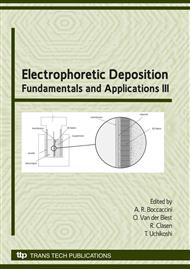p.15
p.21
p.27
p.33
p.39
p.45
p.51
p.59
p.65
Pulsed-DC Electrophoretic Deposition (EPD) of Aqueous Alumina Suspension for Controlling Bubble Incorporation and Deposit Microstructure
Abstract:
Electrophoretic deposition (EPD) from aqueous suspension generally forms deposit containing incorporated bubbles because of evolution of gases at electrodes due to electrolysis of water. We have demonstrated here that application of pulsed voltage /current instead of continuous DC enables controlling the amount of bubble incorporation and obtain bubble-free deposits during EPD of aqueous suspension. The yield and bubble incorporation decreased progressively with decrease in size of the applied pulse. A characteristic band of deposition window was found in the plot of voltage/current vs. pulse width within which smooth and bubble-free deposits are obtained. The window is wider at low applied voltages/currents than at higher voltages/currents implying that it is more easier to control the pulsed EPD at lower applied voltages and/currents. No deposition occurred below the window whereas deposits with incorporated bubbles formed above the window. Suppression of bubbles with decreasing pulse size was attributed to decrease in the amount of hydrogen evolved per pulse and verified by monitoring the gain in weight of palladium (Pd) electrode used as cathode during electrolysis of water.
Info:
Periodical:
Pages:
39-44
Citation:
Online since:
June 2009
Authors:
Price:
Сopyright:
© 2009 Trans Tech Publications Ltd. All Rights Reserved
Share:
Citation:


